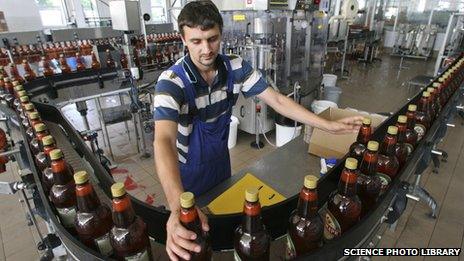US chemistry meeting tackles science of booze
- Published

It was a cocktail party of a decidedly muted and academic sort.
The session called Chemistry at the Bar proved popular with some of the 14,000 scientists at the annual meeting of the American Chemical Society in New Orleans - itself the birthplace of some powerful concoctions.
And if you've ever made a cocktail, that puts you in league with them.
"Making cocktails is something like chemistry at its simplest… adding different ingredients together, experimenting - that's how they've evolved over the years to become as popular as they have," said Neil Da Costa of International Flavors and Fragrances.
Dr Da Costa came to present his work analysing the Hurricane, a cocktail invented in New Orleans in the 1940s as a means to use up rum that publicans had to buy in order to get access to the more prized whiskey.
Cocktails tend to be a rich mix of chemical components - not just the crucial molecule called ethanol, but a great many flavour compounds and "volatiles" that contribute to aroma.
Just what spirits are made from, though, remains hidden, said Jerry Zweigenbaum of Agilent Technologies.
"They're not regulated as a food - you don't see on the label what's in it; all you see is the alcohol content," he told the meeting.
Here in the US, alcoholic beverages are regulated not by the Food and Drug Administration, but by the Bureau of Alcohol, Tobacco and Firearms - with markedly different labelling standards.
Dr Zweigenbaum's work analysed a number of store-bought samples - with widely ranging prices - of the liqueur amaretto.
Historically, it has the taste of bitter almond, thanks to a molecule called amygdalin that was probably originally obtained from apricots.
But applying some serious analytical chemistry tools to modern examples, Dr Zweigenbaum instead found a great deal of benzaldehyde - artificial almond oil.
Across brands that spanned a factor of five in cost and two in alcohol content, he also found a trend in sweetness.
"Initially I thought that to make an inexpensive brand more appealing it would have more sugar, but the analysis showed there was more sugar in the more expensive brands," he said.
Quality control
It's not just spirits that have chemists' attention. Even the humble beer presents a complex combination of chemical components.
Christine Hughey of James Madison University worked with a Danish beer maker called Mikkeller whose brewmaster, she said, "takes a very scientific approach to brewing".
He prepared a number of India pale ales, each using just one hop variety.
Dr Hughey created "molecular fingerprints" of the resulting beers, mapping out the masses of all the molecules within.
Surprisingly, there were marked variations even among 2010 and 2011 versions of the same beer with the same hop - making the technique almost forensic in its precision.
"We can use these molecular fingerprints to determine the year of production, to determine the source, for authentication," she told BBC News.
"I think especially with the craft beer movement, people want to know what they're drinking.
"We've developed 'class prediction models', so if you gave me an unknown [beer], I could say 'the hop used in this beer is East Kent and it was made in 2010'."
Wine has perhaps the most established credentials as a lush mixture of flavours both delicate and bold - mixtures of extraordinary variety, if critiques are anything to go by.
Andreas Dunkel of the Technical University of Munich deconstructed the molecules present in a high-value Italian wine, finding some 82 taste-active compounds that were responsible for the wine's distinctive taste.
But analysis has shown that just 35 of those compounds in varying proportions could be used to effectively reconstruct the taste of any one of the wines Mr Dunkel's team has studied.
It is not about artificially creating a given wine, he said - it is more about quality control and consistency.
"If I know which tastants are really relevant for the final product, I can start breeding studies to increase or decrease certain tastants in the plant or the fruit," he told BBC News.
"Later I can use these results to optimise my production technology - controlling the ageing process in the barrel, for example. The most important thing for a producer of wine is… to have a characteristic quality you have every year."
'Not pretty'
But then there's the morning after - a topic covered in gruesomely chemical detail by Alyson Mitchell of the University of California Davis in her presentation Chemistry and Anatomy of a Hangover.
The hangover is an astonishingly complex physiological phenomenon, with dozens of symptoms and relatively little human trial data - rats and a few undergraduates are the preferred model for much of the relevant research.
Regrettably, although much is known about the chemistry of how the body processes alcohol - and how that can have effects on everything from our digestion to our immune systems - the scientific literature is mute on a cure.
As Prof Mitchell described typical gastrointestinal effects, a groan went up.
"It's not pretty, but we've all been there," Prof Mitchell admonished.
And we have. To those with the notion that scientists are not just like the rest of the population, know this: many from the capacity crowd at Prof Mitchell's talk put their new-found chemical perspectives to use in New Orleans' famed French Quarter on Tuesday night.